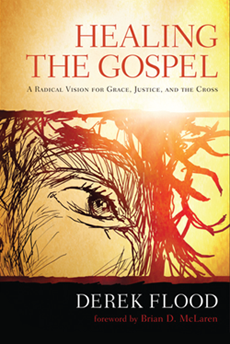Realistic Nonviolence #3: Neuroscience and the Mind of Christ
Wednesday, December 19, 2012
This post is part of a continuing series on practical nonviolence. Read the first post here
In my previous post (post #2), I broadly defined the core of nonviolence and enemy love as a change from a self-focused perspective to a relational perspective. It's about thinking socially, about understanding ourselves as social beings, about the logic of compassion.
As I did last time, I'd like to give a practical application for how we can apply nonviolence and enemy love in our lives. In particular, I'd like to discuss how we can break out of a hostile and defensive mindset, and regain a social perspective.
As I did last time, I'd like to give a practical application for how we can apply nonviolence and enemy love in our lives. In particular, I'd like to discuss how we can break out of a hostile and defensive mindset, and regain a social perspective.
That's particularly hard to do when we in the middle of a conflict. When we're in conflict -- whether or not that conflict is violent -- our perspective changes. It goes from a social orientation to a defensive one. It becomes me against you (or on a larger scale, our group/nation/religion vs. the other).
Think about what it's like when you're in conflict with a loved one: When we're feeling emotionally threatened, we go into defensive mode. When we're in the middle of conflict, all we can see is our own perspective, all we can think about is defending our "rights."
So even if the one we are in conflict with is someone we love, our thinking changes to be us against them. We go into "defense mode" and tragical and ironically end up hurting the very ones we love. Sadly we all know pattern all too well: When we feel
threatened, we close off or say hurtful things we later wish we could take
back.
So I find that while I want to follow Jesus' way of enemy love, I can hardly manage to do this with my loved ones, let alone with a real "enemy." What's going on? Why is it that we can so easily "switch" from being relational to being self-focused when we're in a fight?
Part of the problem is that family is everyone's Achilles heel. There is no place that you are quite as vulnerable. That's good in the sense that we can receive a lot of love there, but it also means we can easily get emotionally triggered in that setting as well.
So it's understandable that we have very real conflicts with our parents, our kids, our spouses. Nevertheless, the question remains: How can we break out of those conflicts? What can we do to reverse those hurtful dynamics in our relationships? What can we do to get back to the social compassionate perspective, rather than getting instantly sucked into a "me-focus" when things get tense, and we feel emotionally threatened?
I'd like to suggest that new research in neuroscience can give us some really important insights into what's going on here, and how we can learn to break out of that destructive self-focus:
When we are triggered in an argument, feeling flooded and emotionally
threatened, this activates the amygdala, which is the part of the brain
involved in the processing of raw emotions such as anger and fear. The
amygdala is essentially the brain's watchtower, and when it is fired up
in alarm mode, it sends out neurochemicals which effectively shut down
the prefrontal cortex. The prefrontal cortex is the part of your brain
associated with things like relational connection, empathy, impulse
control, self-reflection, moral judgement and conscience -- in short,
the part of your brain in charge of what we might call the social-self.
The brain's "shut-down" function has a practical survival function:
It means that when we are in danger our brain kicks into alarm mode
which can save our life. But it also means that when we get triggered in
a argument with a loved one, the smart and compassionate part of our
brain is temporarily turned off, which can make us do thoughtless and
hurtful things.
So there's a very real reason neurologically that we become so
self-focused in a fight. It's not a reflection of our character, so much
as it is a kind of brain reflex based on a perceived threat. When we
are unaware of this, we can get swept up in those feelings. But once we
recognize what is happening, we can address what's going on in us. This involves a two-step process:
The first step is
to recognize what is going on in our bodies. The part of
our brain in charge of making good judgments has been temporarily shut
down by our amygdala. Paul was very likely observing this dynamic when
he contrasted the "flesh" with the "fruits of the Spirit." What we can
now better understand from brain science is that this "fleshly" reaction
of self-focused anger and fear in us is not something evil or bad in itself. It's a protective reflex of
the brain. This can be life-saving when we are in actual danger, but
becomes dysfunctional when emotional reactivity makes us see an "enemy"
in a loved one. It's a good thing that is out of balance.
This brings us to the second step: We need to have the maturity and
humility to recognize that because we are emotionally triggered, we may need
to allow time for our social brain to come back online. We might compare this to having the maturity to recognize when
you've had too much to drink, and handing over your car keys. Similarly,
when we're "under the influence" of the amygdala, we need to recognize
that the smart and social part of our brain is impaired, and
consequently have the maturity so let it wait, to cool down first.
There's a temptation here to simplify the above equation, focusing on
only one of the above two points: Some may want to stress the fact that
the "flesh" of emotional reactivity is an involuntary bodily reaction
which is not our conscious choice, and therefore argue that it is "not
our fault." Others will stress the opposite point, arguing that we need
to take charge of our ingrained behavioral patterns and feelings. The
reality is that both are true at the same time. We therefore need to
have a complex and integrated understanding of how these two seemingly
opposed factors work in tandem:
On the one hand, understanding what is going on in our brains means we do not need to beat ourselves up about it. This is our body's unconscious involuntary reaction to feeling emotionally threatened, separated, insecure. Understanding what is going on in us can be comforting and normalizing. These are not bad choices we are making. In fact, they are not choices at all; they are involuntary reactions to a perceived threat. The thinking and social part of our brain has literally been shut down by our brain's panic center.
On the one hand, understanding what is going on in our brains means we do not need to beat ourselves up about it. This is our body's unconscious involuntary reaction to feeling emotionally threatened, separated, insecure. Understanding what is going on in us can be comforting and normalizing. These are not bad choices we are making. In fact, they are not choices at all; they are involuntary reactions to a perceived threat. The thinking and social part of our brain has literally been shut down by our brain's panic center.
We can't help how
we feel, but we can learn to mange what we do with
those feelings, so we are not driven by emotional reactivity. Simply
realizing that our thinking and social-self is impaired is not enough
however. Instead, we need to learn to recognize when we are flooded with
reactive emotion, and exercise the maturity, humility and
responsibility to wait until we can cool off and think socially again.
Noticing when we are emotionally triggered is a really important step towards not being driven by our amygdala. It also helps to name what is going on in us, saying something like "I'm feeling really triggered right now, and need some time." When we do this we are engaging the thinking and social part of our brains, and the more we do that, the more our brain will strengthen those neural connections. This is a concept known as neuroplasticity, which refers the brain's ability to change itself based on our experiences. Paul tells us that as we walk in this way of the Spirit, we will be "transformed by the renewing of our minds" and that's exactly what our brain does. Amazingly, our brain actually structurally changes, based on the input it receives, creating new synaptic linkages and even growing new neurons. This means that, as we learn to engage our thinking and social prefrontal cortex in times of stress, our brain re-wires itself over time to be more naturally compassionate and social, and less driven by our "carnal" reactive emotions.
Noticing when we are emotionally triggered is a really important step towards not being driven by our amygdala. It also helps to name what is going on in us, saying something like "I'm feeling really triggered right now, and need some time." When we do this we are engaging the thinking and social part of our brains, and the more we do that, the more our brain will strengthen those neural connections. This is a concept known as neuroplasticity, which refers the brain's ability to change itself based on our experiences. Paul tells us that as we walk in this way of the Spirit, we will be "transformed by the renewing of our minds" and that's exactly what our brain does. Amazingly, our brain actually structurally changes, based on the input it receives, creating new synaptic linkages and even growing new neurons. This means that, as we learn to engage our thinking and social prefrontal cortex in times of stress, our brain re-wires itself over time to be more naturally compassionate and social, and less driven by our "carnal" reactive emotions.
Of course it's never easy to change old
patterns. It involves humility and hard work. But hopefully, understanding how our
minds work can help us get a little closer to having the "mind of
Christ" as we learn to follow in that way.
Labels: nonviolence





